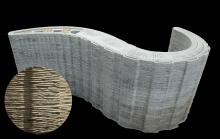Bringing the digital revolution to the construction industry, 3D printing allows complex geometric structures to be created at a reasonable cost and with shorter production times compared to traditional techniques. LafargeHolcim has identified three potential markets: high value-added architecture, the individual construction of affordable homes, and the robotic construction of prefabricated building elements.
In its R&D centre in L’Isle d’Abeau near Lyon, LafargeHolcim teams have leveraged their scientific and technological expertise to design a range of experimental concrete mixes suitable for 3D printing.
LafargeHolcim has developed and provided materials designed specifically for the creation of two different 3D printed structures:
• A load-bearing post printed by XtreeE and assembled by Fehr Architectural, with a height of 4 meters (about 13 feet), being used to support the playground roof of a middle school in Aix-en-Provence in France. This is the first 3D printed structural element to be marketed in Europe
• A pavilion created on behalf of the Ile-de-France regional authority using a revolutionary design, the fruit of a collaborative project bringing together XtreeE, Dassault Systèmes, ABB and LafargeHolcim
These advances are said to underscore LafargeHolcim’s commitment to delivering innovative solutions that create value for its customers. LafargeHolcim’s R&D centre is the world’s largest within the construction materials sector, with a portfolio of 1,750 patents, and employs more than 200 researchers.
“Innovation is part of our DNA in order to respond to the trends in tomorrow’s construction market,” explains Gérard Kuperfarb, Group Head of Growth & Innovation at LafargeHolcim. “We are therefore proud to be positioned as a pioneer in 3D printing, a revolutionary technique that brings greater accuracy while considerably reducing construction times.”





